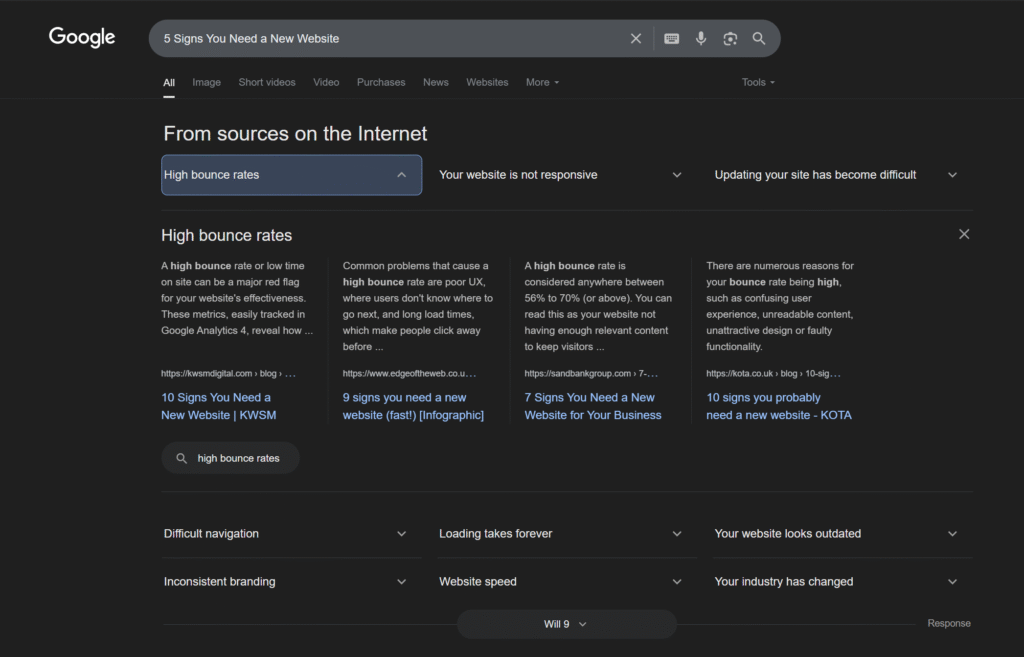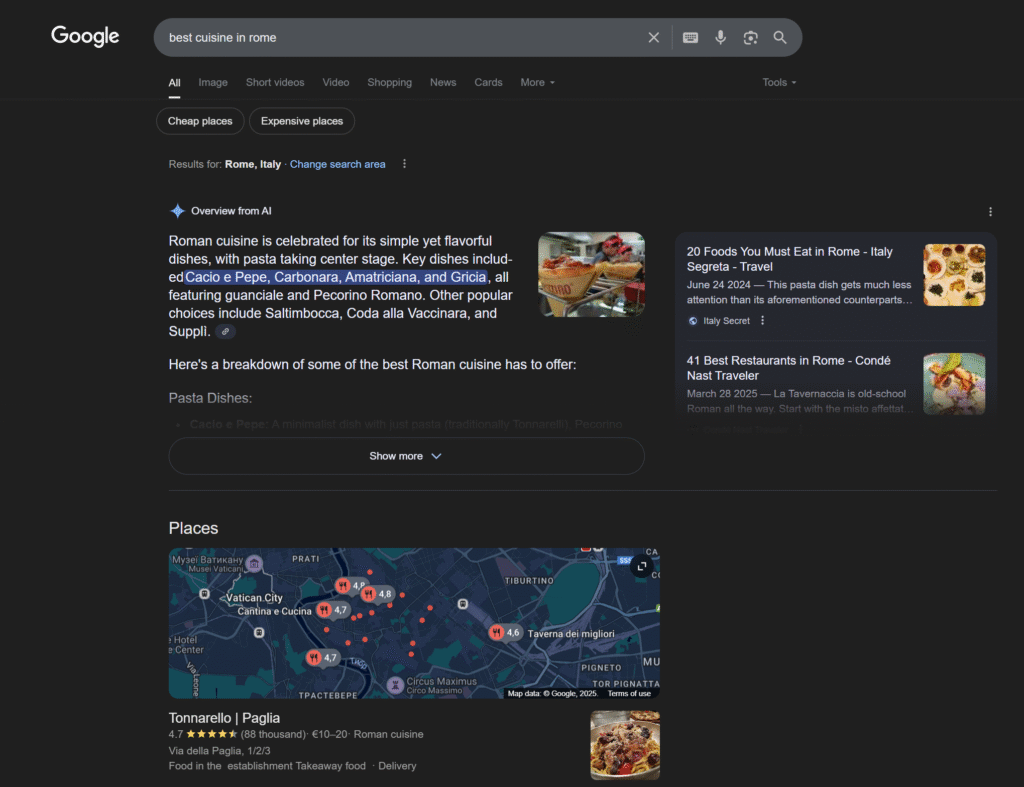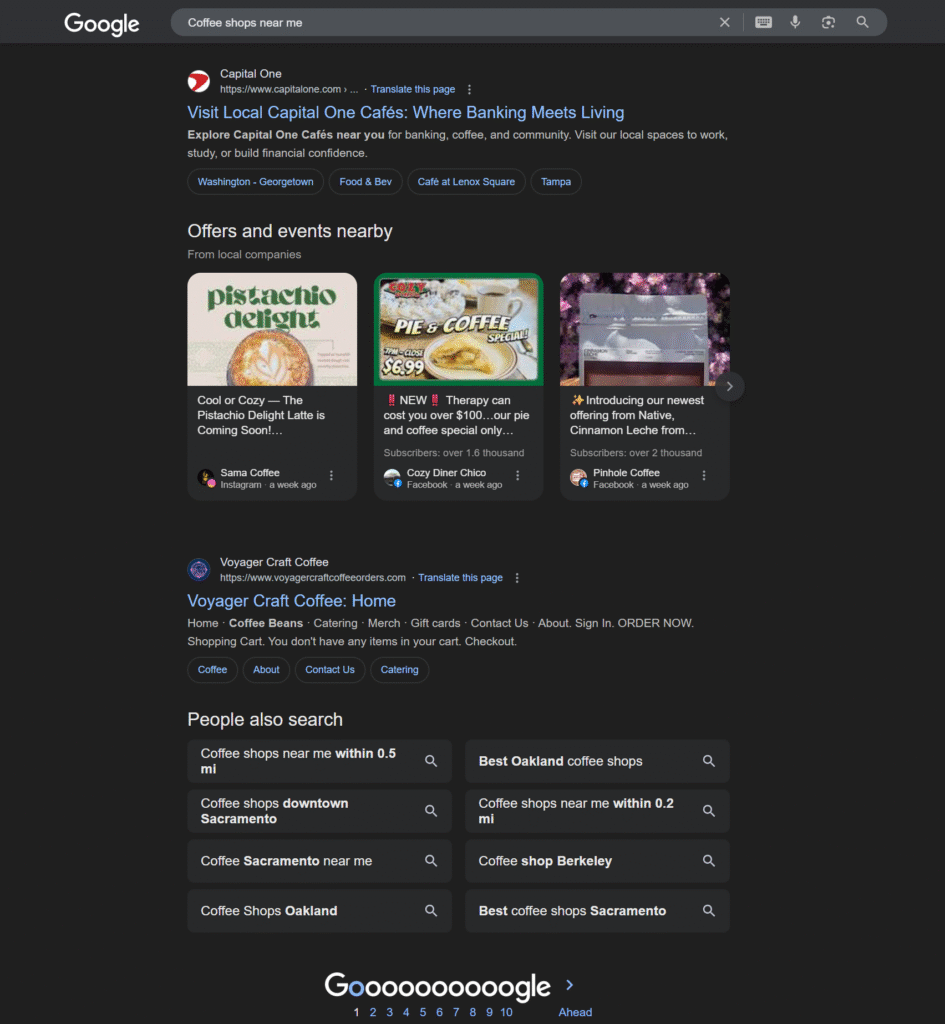On July 10th, 2025, something big happened in the SEO world.
Instagram officially opened the floodgates to search engines.
For the first time in the platform’s history, public content from professional accounts can now appear directly in Google search results.
And it’s already creating massive opportunities for brands that know how to capitalize on it.
What Actually Changed (And Why It Matters)
Here’s the deal:
Until July 10th, Instagram used robots.txt files and noindex tags to keep search engines out. It was like having a “Do Not Enter” sign on every piece of content.
But here’s what’s interesting…
Google was already sneaking in and indexing millions of Instagram posts anyway. Especially Reels, videos, and profiles.
According to SEOZoom data, Instagram content appears in the top 10 results for over 669,000 keywords in Italy alone, with over 600,000 Instagram Reels currently indexed by Google.
The July update didn’t create this phenomenon. It made it official.
Now Instagram is basically saying, “Hey Google, come on in. Index whatever you want from our professional accounts.”
And that changes everything.
The Search Landscape That Made This Inevitable
Before we dive into the opportunities, you need to understand WHY this happened.
Traditional organic search is getting crushed.
AI-generated answers now show up in 16% to 42% of queries. This shift can reduce organic click-through rates by 34–37%. Some sites report up to 64% traffic loss in affected SERPs.
Think about it:
When someone searches for “how to make sourdough bread,” they’re increasingly getting AI-generated answers right in the search results. No click required.
This is forcing brands to diversify beyond traditional website SEO.
And Instagram just became a major piece of that puzzle.
The Birth of “SEOcial” Marketing
Smart agencies have been preparing for this convergence for months.
They’re calling it “SEOcial”—the fusion of social media and SEO strategies.
Here’s why it’s so powerful:
Your Instagram content now serves dual purposes:
- Engaging your existing followers
- Capturing brand new search traffic
It’s like having a blog post that can also go viral on social media.
Instagram posts can now act like mini landing pages, increasing opportunities for discoverability, traffic and engagement beyond the platform itself.
Which Industries Are Winning Big
Not all sectors are created equal when it comes to social search visibility.
The data reveals clear winners:
Visual-First Industries Dominate
Fashion and Beauty These brands were born for visual search. A single Instagram post showcasing a new product can now rank for “summer fashion trends 2025” alongside traditional fashion blogs.
Food and Beverage Recipe videos and food photography are search gold. The platform shows strongest SERP visibility around position 4, indicating real opportunity—especially for visual, lifestyle, and trend-driven sectors.
Home Decor and Design Before-and-after transformations and design inspiration posts are naturally search-friendly content that people actively seek out.
Experience-Based Businesses Clean Up
Travel and Tourism Destination photos and travel tips are perfect for capturing search traffic from people planning trips.
Restaurants and Hospitality Local searches like “best brunch in Chicago” now surface Instagram content alongside Yelp reviews.
Entertainment and Events Behind-the-scenes content and venue showcases appear in searches for local entertainment options.
The B2B Opportunity Everyone’s Missing
Here’s what most people don’t realize:
B2B brands have a massive opportunity here too.
SaaS companies can showcase product demos and customer success stories that rank for software comparison searches.
Professional Services can position thought leadership content to appear when prospects research industry topics.
Healthcare and medical services can share educational content that ranks for health-related queries.
The key is creating content that serves both social engagement AND search intent.
Why Traditional SEO Metrics Are Becoming Obsolete
Here’s something that’ll blow your mind:
Almost 40% of Italian SERPs feature at least one piece of social content, with differences depending on vertical market sectors.
This isn’t just an Instagram phenomenon. It’s a complete shift in how search results work.
Google is increasingly mixing social content with traditional web pages because:
- Freshness Factor: Social content is updated constantly
- Engagement Signals: High engagement indicates quality content
- Visual Appeal: Images and videos enhance user experience
- Real-Time Relevance: Social reflects current trends and conversations
Traditional SEO focused on domain authority and backlinks.
Social SEO focuses on engagement, relevance, and visual appeal.
It’s an entirely different game.
The Content Types That Perform Best in Search
Not all Instagram content is created equal when it comes to search visibility.
Here’s what’s working:
Educational Carousels

Multi-slide posts that answer specific questions perform incredibly well. Think “5 Signs You Need a New Website” or “How to Style a Small Living Room.”
Behind-the-Scenes Content
People search for “[brand name] behind the scenes” more than you’d think. This content humanizes your brand while capturing branded search traffic.
How-To Videos and Reels
A local gym’s Instagram video on proper squat form could appear when someone searches “how to squat properly.”
Location-Based Content

Geo-tagged posts appear in local searches. A restaurant’s signature dish Reel might rank for “best [cuisine] in [city].”
FAQ-Style Posts
Content that directly answers common questions in your industry has huge search potential.
The Massive Opportunity in Social Listening for SEO
Here’s a strategy most SEOs are completely missing:
Social listening for SEO keyword discovery reveals real-time insights into how audiences discuss topics, providing keyword opportunities that traditional research might miss.
Think about it:
Traditional keyword research shows you what people searched for last month.
Social listening shows you what people are talking about RIGHT NOW.
You can spot trending topics, emerging terminology, and conversation patterns that haven’t shown up in keyword tools yet.
This gives you a massive first-mover advantage in creating content around these topics.
Why Early Adopters Are Already Winning
Early adoption of Instagram indexing optimization provides first-mover advantages in search results. Brands that optimize quickly can establish authority in search results before competitors adapt their strategies.
Here’s the thing:
Most brands are still treating Instagram like it’s 2019. They’re focused purely on followers and engagement.
Meanwhile, smart brands are optimizing their Instagram content like it’s part of their website.
They’re:
- Using keyword-rich captions
- Creating content that answers search queries
- Optimizing their bio for discovery
- Building topical authority through consistent, valuable content
And they’re getting rewarded with search traffic that their competitors don’t even know exists.
The Local SEO Revolution
One of the biggest opportunities is in local search.
Instagram and TikTok both offer searchable map features that help users find businesses and popular locations nearby, offering relevant brands a huge opportunity.

This is huge for local businesses.
Your Instagram posts can now appear when someone searches for:
- “Coffee shops near me”
- “Best pizza in Brooklyn”
- “Hair salons in downtown Portland”
It’s like having your content appear in the local pack, but through social media.
The Global Scale of This Shift
Let’s put this in perspective:
According to Forrester, 32% of users in the US have used Instagram in the last month to search for content.
That’s not just social browsing. That’s active searching.
Instagram is becoming a search engine in its own right, and now that content is flowing into Google too.
Social content is becoming a core part of search results, particularly when users search for entertainment, tourism, food, culture, or trending topics.
What This Means for the Future of SEO
This Instagram update isn’t just about one platform.
It’s a preview of where SEO is heading:
Multi-Platform Optimization becomes essential. You can’t just optimize your website anymore.
Visual Content becomes as important as written content for search rankings.
Real-Time Relevance matters more than evergreen authority.
Engagement Signals start influencing search rankings across platforms.
Social Listening becomes a core SEO skill.
We’re moving from “website SEO” to “brand ecosystem SEO.”
The Hidden Technical Details Nobody’s Talking About
Here’s where it gets really interesting.
Most coverage of Instagram’s update misses the crucial technical nuances that reveal the true scope of this change.
The Retroactive Content Goldmine
One detail that’s flying under the radar: Instagram is allowing indexing of public content uploaded from January 1st, 2020, onwards from criteria-meeting accounts.
Think about that for a second.
If you’ve been posting quality content since 2020, you’re sitting on five years of potentially indexable content that could start appearing in search results.
This isn’t just about new posts—it’s about your entire content archive becoming searchable overnight.
The Robots.txt Revelation
Here’s the technical reality that most people are missing:
Instagram specifies that it requires search engines to not index its content through robots.txt files and noindex tags, which function as a request to respect public privacy, but do not represent an absolute technical block.
Translation: Google has been ignoring Instagram’s “please don’t index us” requests for years.
Google, in fact, has chosen to partially ignore this request, indexing millions of public posts from Instagram. Other search engines — such as Bing and DuckDuckGo — follow the guidelines more strictly, but not uniformly.
This explains why you might have occasionally seen Instagram content in search results before July 10th. Google was already playing by their own rules.
The Position 4 Sweet Spot
SEOZoom’s data reveals something fascinating about Instagram’s search performance: the data shows a high frequency from the second position onwards, with an absolute peak in fourth place.
Position 4 is the sweet spot for Instagram content.
This isn’t random—it suggests Google views social content as supplementary to traditional web results, but valuable enough to consistently rank in the top half of the first page.
The Filename Optimization Secret
Here’s a tactic that forward-thinking agencies have been quietly implementing:
We’re optimizing everything from captions to filenames to keep our clients at the forefront.
Most brands upload images and videos with default camera filenames like “IMG_1234.jpg” or “VID_20250710.mp4.”
Smart brands are renaming files before upload with descriptive, keyword-rich names like “summer-fashion-trends-2025.jpg” or “sourdough-bread-recipe-tutorial.mp4.”
Google can read these filenames, and it’s an optimization opportunity that 99% of Instagram users are completely ignoring.
The Stories Exclusion Strategy
One crucial limitation that’s been buried in the fine print: This covers Instagram posts, Reels, carousels, and videos, but notably excludes Stories, which remain ephemeral by design.
Stories stay off-limits to search engines.
This creates an interesting strategic opportunity—you can use Stories for behind-the-scenes content, teasers, and time-sensitive promotions without worrying about search indexing, while keeping your permanent posts optimized for discovery.
The TikTok Precedent That Changes Everything
Here’s the context that makes Instagram’s move inevitable:
Since 2023, TikTok videos have been showing up in 15% of Google how-to searches. Those short clips are grabbing 3.2x more traffic than your average blog post.
Instagram watched TikTok eat their lunch in search visibility and decided to fight back.
But here’s Instagram’s secret weapon: more content formats, better business tools, and a massive head start in brand trust.
While TikTok opened the door to social search, Instagram is positioned to dominate it.
Essential Data Resources & Visual Insights
To help you leverage these insights and benchmark your own performance, here are the key data sources and visual resources that every advanced SEO should have in their arsenal:
Critical Industry Reports (Free Downloads)
1. SEOZoom’s Instagram Indexing Data Study The most comprehensive analysis of Instagram’s search presence includes:
- 669,359 keywords where Instagram content appears in Google’s top 10
- 613,495 Instagram Reels currently indexed by Google
- Position distribution showing Instagram’s “sweet spot” at position 4
- Geographic breakdown by market sector Access: SEOZoom Instagram Indexing Report
2. SocialPilot’s Instagram Trends Report 2025 Based on analysis of 4.4 million posts from 45,700 accounts:
- Industry engagement rates up to 8.4% (revealing the top-performing sectors)
- Caption styles driving 70% more comments
- Content types achieving 3.8x more reach
- Video length optimization data showing 24% boost in shares Download: Instagram Trends Report 2025
3. Rival IQ’s 2025 Social Media Industry Benchmark Report Cross-platform analysis of 4+ million posts across 14 industries:
- Instagram vs. TikTok engagement rates by sector
- Content format performance data
- Industry-specific hashtag effectiveness
- Post frequency optimization benchmarks Download: 2025 Social Media Benchmark Report
Key Data Visualizations & Statistics
Instagram’s Search Dominance by the Numbers:
- Instagram appears in 11% of Italian SERPs (SEOZoom data)
- 40% of all Italian SERPs feature social content
- Instagram ranks 4th globally for website traffic (behind Google, YouTube, Facebook)
- 61% of users turn to Instagram for product discovery (beating all other platforms)
The Social Search Revolution:
- 36% of users are using Instagram like Google for search
- 32% of US users have used Instagram for search in the last month
- 15% of Google how-to searches now feature TikTok videos
- Social content gets 3.2x more traffic than average blog posts
Visual Resources for Presentations
HubSpot’s 2025 Social Media Trends Report Data from 1,200+ Global Marketers:
- Social commerce growth projections
- Video content performance metrics
- AI usage in content creation
- Expert panel insights Download: 2025 Social Trends Report
Actionable Benchmark Data
Content Performance Metrics:
- Short videos (<15 seconds) perform best for brand content
- Carousels outperform single posts for complex topics
- Educational content sees 77% more backlinks than promotional content
- Long-tail keywords will become increasingly important with AI overviews
Platform-Specific Insights:
- Instagram engagement rate: 0.50% (down 28% YoY but 3x higher than Facebook)
- 29% of users make purchases directly on Instagram
- 72% of Gen Z prefer Instagram for customer care
- Stories have 35% higher reach rates for brands under 10k followers
What SEO Experts Are Saying About the Social Search Revolution
The industry’s top voices are taking notice of this seismic shift.
Rand Fishkin, co-founder of SparkToro and former CEO of Moz, has been particularly vocal about the changing search landscape. In a recent interview, he emphasized, “Think of digital channels, especially emerging search and social networks (ChatGPT, Perplexity, TikTok, Reddit, YouTube, et al.) like billboards or television. Your job is to capture attention, engage, and do something memorable that will help potential customers think of your brand the next time they have the problem you solve.”
Fishkin’s advice couldn’t be more relevant to Instagram’s indexing update. He’s advocating for exactly what this change enables: using social platforms to build brand awareness that translates into search visibility.
Aleyda Solis, international SEO consultant and author of the popular SEOFOMO newsletter, has been tracking the AI and social search evolution closely. In her recent analysis of AI search trends, she noted: “While ChatGPT traffic is growing, it’s still minimal compared to Google (5.14B vs 81.31B visits in April 2025). Google has experienced a slight yearly traffic decrease (-0.89% YOY), but it’s Bing that has seen a much larger drop (-21.76%) in the last year.”
This data supports why Google is embracing social content indexing—they’re fighting to maintain their dominance as search behavior evolves.
Solis also emphasizes the importance of long-tail optimization in this new era: “Target and focus more on answering the long tail queries of your users. We are going to see a much bigger and more important impact from those as a consequence of the AI overviews and personalised AI results that we expect to have in the not-too-distant future.”
John Mueller from Google’s Search Relations team has provided insight into the technical side of this evolution. At Google Search Central Live in Madrid, he explained how “search is not a solved problem: new platforms, new user preferences, new technologies are arising. Google has provided and will continue to provide value through search to the web: value to the web users and the web ecosystem.”
This directly explains Google’s motivation for indexing Instagram content—they’re adapting to where users are actually spending their time and searching for information.
Industry thought leaders are unanimous: the convergence of social and search isn’t coming—it’s here.
The Bottom Line
Instagram’s July 10th update represents the biggest shift in SEO since mobile-first indexing.
This update transforms Instagram from a social platform into a searchable content powerhouse. It will allow brands to reach new audiences directly from Google and fundamentally changing the digital marketing landscape.
The brands that recognize this shift and adapt quickly will capture market share from competitors who are still stuck in the old SEO playbook.
As Rand Fishkin puts it, “all that latent awareness and engagement leads to branded Google searches”—exactly what Instagram indexing now enables at scale.
The question isn’t whether social search will become important.
It already is.
The question is whether you’ll be early to the party or scrambling to catch up later.
Because once your competitors figure this out, the first-mover advantage disappears.
And in SEO, timing is everything.
References
- Instagram’s July 10th Update: What It Means for Your Brand’s Visibility on Google | South Made
- The biggest Instagram updates from 2025: A social media manager’s guide | HeyOrca
- Instagram in Search: What the July 2025 Update Means for Your Brand – Elixirr Digital
- July 2025 Instagram Update: What Instagram’s New Indexing Feature Means for Brand Visibility
- Instagram on Google: will indexing rules change from July 10? – SEOZoom
- Instagram on Google Search: What to Know by July 2025
- Meta’s July 2025 Update: How to Optimize Your Instagram and Facebook Posts for Google Search
- Instagram to Automatically Display Public Photos and Videos in Search Engine Results
- 15 social media trends shaping 2025 [mid-year update] | Hootsuite
- Instagram Indexing and SEO Strategy: How to Boost Discoverability in 2025
Is a senior SEO expert with over a decade of experience dominating the digital marketing battlefield. Since 2023, I’ve been riding the AI wave. Since 2024, I have started to work with the SEO Bazooka Blog.

Leave a Reply